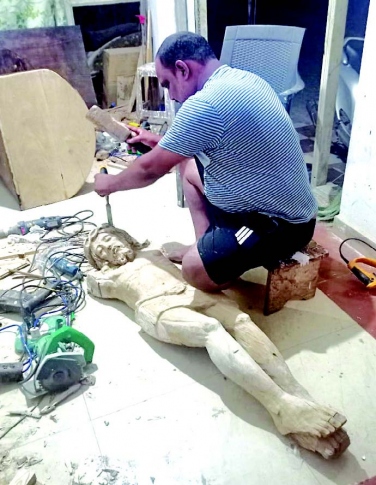
Frazer Andrade
India is truly blessed with a rich diversity in terms of both, natural and manmade heritage with a similar understanding on the importance of preserving and protecting Mother Nature. Associating religious sentiments to various elements wherever needed, Indians have always been able to live harmoniously in complete oneness with nature. The current generation needs to understand the concept of sustainability and a sustainable way of living.
Since times immemorial, our ancestors have always strived towards beautifying a place during festivities but never was this done at the cost of destroying nature and polluting the environment. For centuries, people have been using materials sourced from nature itself which would go back to the soil after their intended use. Now, just look around at the amounts of plastic in different forms used as beautifying materials on occasions of feasts and zatras.
Joshua Dias, a youth from Fatorda,
Margão, says that the joy of putting up a lantern during Diwali and a star during Christmas lights a spark of joy in one’s hearts, but little does one realize that it is lowering that spark every time materials like plastic is used in the making of these festive articles.
The plastic used in these articles in the later stage piles up to become heaps of environmental hazardous waste, the consequences of which slowly turn into issues such as land pollution which is not only unhealthy for the environment but also for the animals that depend on it. Similarly, it also leads to water pollution which affects marine flora and fauna, which not only poses a threat to their habitat but indirectly to our livelihood as well on consumption of food sourced from such polluted water bodies.
It is indeed a beautiful practice of making a crib set up in every Catholic home during Christmas. But once the season for Christmas comes to an end, the crib actually transforms into a burden
on to nature. It is not surprising to see Thermocol crib décor disposed of into road side bins or a Plaster of Paris (POP) image of Lord Ganesha washed onto the shore along the coast, post the Ganesha celebrations.
Luke Conçeição Pereira, a youth from Carmona, points out to a beautiful practice of the lighting candles outside roadside crosses observed among many. However, seeing the faithful, dispose of the candle wrappers, around the Cross, they intend to venerate, is disgusting in all aspects, he adds in frustration. Speaking about religious art, one needs to understand that one should be saying no to non-biodegradable materials like plastics and POP, while purchasing idols for worship and veneration. Goa at one time had several artists sculpting images from wood and stone.
Taking a look around Goa today, one will notice that it is not only the art of making sculpture in Goa that is disappearing, but also are it’s makers and their craftsmanship. Diela Dias, an art lover from Fatorda, Margão, strongly believes that, a probable reason for loss in intricate detailing in artworks of today’s times is that the church emphasizes more on spirituality and pays least attention to beautification of religious buildings. Another reason could be that traditionally the church would cater only to wealthier sections of society and hence most of the sacred art was commissioned by the rich while now the church is very much open to all sections of society. Hence, even the not so rich are free to make their offerings to the church building in terms of art works and other requirements. However, these families would definitely not want to pay the craftsmen as much as the richer sections of society would. Therefore, the artisans didn’t put in much efforts while they worked of such low budgeted commissions.
Lazar Fernándes, one of the few surviving Goan wood sculptors from Raiá, mentions that he finds it extremely difficult to continue with his family occupation of making wooden sculpture, with almost no demand for wooden sacred art in today’s time since wood has almost completely been substituted with plastics. Lazar mentions that his family has been into wood sculpting since the last century. His father, Pedro Antonio Costa Fernandes would sculpt with loads of love and passion which he has now taken over, he adds. In those days they were restricted only to carving Christian sculpture for churches, chapels and private homes, but today Lazaro is very open to sculpt images for clients of any faith. He states that the wood generally used in sculpting is teak, Shivann (Gmelina arboria) and jackfruit. Shivann is a light weight white wood and was generally used to build high altars and big statues in churches to reduce the weight of elaborate carvings/statues mounted/placed on/at high locations. He states that Rosewood and Ebony was rarely used since it was hard to carve, heavy and costlier.
Joyce Aguiar e Carvalho, from Colva mentions that in Christianity, the most commonly followed practice of doing away with old unwanted sacramentals is to burn them or bury them. Today, the market is flooded with sacred art made of plastic. Now is the time to say a big no to plastic sacramentals and instead opt for wood or other natural materials. There are wonderful artists like Lazaro from Raia, striving very hard to upkeep his family tradition of sculpting in wood. It is important to patronize traditional local craftsmen and at the same time opt for greener figures of God to adorn altars at home.
This World Earth Day, let us make a resolution to celebrate in a responsible manner keeping in mind the consequences of our actions.
